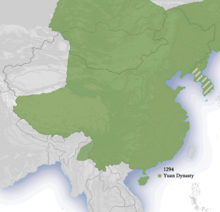Manchuria under Yuan rule
| Liaoyang Province 遼陽等處行中書省 | |||||||||||
|---|---|---|---|---|---|---|---|---|---|---|---|
| Province of the Yuan dynasty | |||||||||||
| 1271–1368 | |||||||||||
 Manchuria within the Yuan dynasty under the Liaoyang province | |||||||||||
| Capital | Yizhou | ||||||||||
| • Type | Yuan hierarchy | ||||||||||
| History | |||||||||||
• Established | 1271 | ||||||||||
• Disestablished | 1368 | ||||||||||
| 1387 | |||||||||||
| |||||||||||
Manchuria under Yuan rule refers to the
History
| History of Manchuria |
|---|
 |

Conquest of Manchuria
In 1211, after the conquest of
Yuan rule
Having destroyed existing governmental structures and displaced political elites, the Mongols did not immediately establish firm control. Rather, the Mongols developed a fluid system of governance in Manchuria designed to extract economic and military resources while maintaining local stability. With the establishment of the
After Nayan's defeat the Liaoyang province was re-established to govern Manchuria, and it oversaw seven
Kublai Khan's efforts to restore order in the region after the revolts by Nayan and Qadan reflect the complex nature of Manchuria under the Mongols. The establishment of the Liaoyang province was part of his efforts to consolidate control over Manchuria. He also appointed such loyal generals as the Korean Hong Kun-sang to senior posts within the administration of Manchuria. Finally, Kublai Khan was careful to permit Nayan's relatives to retain his lands and privileges. The Yuan court needed the allegiance of the Mongol aristocracy as a whole even when it was forced to strike against individual members. Kublai stove to balance the interests of the Goryeo throne, local Mongol nobles, leaders of the Korean community in Manchuria, and his own court to restore order in the northeast.[3]
During the 14th century, no open military conflict marred relations between the Yuan court and the imperial princes in Manchuria. The Liaoyang province exercised more local control than in previous decades. However, the Yuan government still felt the need to periodically dispatch special emissaries to assist officials in Manchuria in tours of inspections. In sum, the Mongol court continued to work at a balance among its own interest, Chinese populations, center-oriented local administration, and Mongol princes in the region. According to
See also
- Mongol conquest of the Jin dynasty
- Manchuria under Ming rule
- Manchuria under Qing rule
- Korea under Yuan rule
- Mongolia under Yuan rule
- Tibet under Yuan rule
- Yuan dynasty in Inner Asia
- History of Manchuria
References
- ^ The Cambridge History of China: Volume 6, Alien Regimes and Border States, by Denis C. Twitchett, Herbert Franke, John King Fairbank, p488
- ^ Empire's Twilight: Northeast Asia Under the Mongols, by David M. Robinson, p34-35
- ^ Empire's Twilight: Northeast Asia Under the Mongols, by David M. Robinson, p38-39

